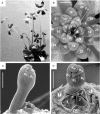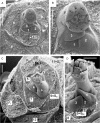Sympodial construction of Fibonacci-type leaf rosettes in Pinguicula moranensis (Lentibulariaceae)
- PMID: 17720680
- PMCID: PMC2749640
- DOI: 10.1093/aob/mcm184
Sympodial construction of Fibonacci-type leaf rosettes in Pinguicula moranensis (Lentibulariaceae)
Abstract
Background and aims: The leaf rosettes of the carnivorous Pinguicula moranensis follow a spiral phyllotaxis approaching a Fibonacci pattern while the stalked flowers arise from extra-axillary sites between the leaves. The organization of this rosette has been discussed by various authors, with various results. The aim of the present study was to clarify the development of the flowering rosettes of this species.
Methods: The formation of the rosettes is shown with the aid of scanning electron microscopy.
Key results and conclusions: The scanning electron micrographs show that each flower terminates an article (sympodial unit). The leaves of consecutive articles of such sympodially constructed rosettes are arranged along a spiral Fibonacci pattern (with divergence angles around 137 degrees). This results from homodromy of leaf initiation in consecutive articles with the first leaf (prophyll) of a new article inserted in an obliquely transverse position next to the floral scape that terminates the former article. Sympodial construction of flowering shoots and leaf rosettes is also known from Aloe, Gunnera and Philodendron. As a by-product of this study, the unidirectional development of the Pinguicula flower is confirmed and discussed.
Figures


Similar articles
-
Floral development of Sabia (Sabiaceae): evidence for the derivation of pentamery from a trimerous ancestry.Am J Bot. 2015 Mar;102(3):336-49. doi: 10.3732/ajb.1400388. Epub 2015 Mar 13. Am J Bot. 2015. PMID: 25784467
-
Floral anatomy and vegetative development in Ceratophyllum demersum: a morphological picture of an "unsolved" plant.Am J Bot. 2015 Oct;102(10):1578-89. doi: 10.3732/ajb.1500124. Epub 2015 Sep 29. Am J Bot. 2015. PMID: 26419811
-
Flower nectar trichome structure of carnivorous plants from the genus butterworts Pinguicula L. (Lentibulariaceae).Protoplasma. 2020 Jan;257(1):245-259. doi: 10.1007/s00709-019-01433-8. Epub 2019 Aug 19. Protoplasma. 2020. PMID: 31428856 Free PMC article.
-
Floral phyllotaxis in basal angiosperms: development and evolution.Curr Opin Plant Biol. 2007 Feb;10(1):52-7. doi: 10.1016/j.pbi.2006.11.007. Epub 2006 Nov 30. Curr Opin Plant Biol. 2007. PMID: 17140838 Review.
-
Prophyll in Monocots: The Starting Point of Lateral Shoot Phyllotaxis.Front Plant Sci. 2022 Apr 13;13:855146. doi: 10.3389/fpls.2022.855146. eCollection 2022. Front Plant Sci. 2022. PMID: 35498710 Free PMC article.
Cited by
-
Microscopy observations reveal a new glandular morphology in four Pinguicula L. species.BMC Res Notes. 2024 Dec 19;17(1):367. doi: 10.1186/s13104-024-07021-1. BMC Res Notes. 2024. PMID: 39702413 Free PMC article.
-
Evolution of unusual morphologies in Lentibulariaceae (bladderworts and allies) and Podostemaceae (river-weeds): a pictorial report at the interface of developmental biology and morphological diversification.Ann Bot. 2016 Apr;117(5):811-32. doi: 10.1093/aob/mcv172. Epub 2015 Nov 20. Ann Bot. 2016. PMID: 26589968 Free PMC article. Review.
-
Developmental Flower and Rhizome Morphology in Nuphar (Nymphaeales): An Interplay of Chaos and Stability.Front Cell Dev Biol. 2020 May 19;8:303. doi: 10.3389/fcell.2020.00303. eCollection 2020. Front Cell Dev Biol. 2020. PMID: 32509775 Free PMC article.
-
Effects of Geometric Sound on Brainwave Activity Patterns, Autonomic Nervous System Markers, Emotional Response, and Faraday Wave Pattern Morphology.Evid Based Complement Alternat Med. 2024 Mar 29;2024:9844809. doi: 10.1155/2024/9844809. eCollection 2024. Evid Based Complement Alternat Med. 2024. PMID: 38586300 Free PMC article.
References
-
- Albert VA, Williams SE, Chase MW. Carnivorous plants: phylogeny and structural evolution. Science. 1992;257:1491–1495. - PubMed
-
- Barthlott W, Porembski S, Seine R, Theisen I. Karnivoren. Stuttgart: Verlag Eugen Ulmer; 2004.
-
- Bremer B, Bremer K, Heidari N, Erixon P, Olmstead RG, Anderberg AA, et al. Phylogenetics of asterids based on 3 coding and 3 non-coding chloroplast DNA markers and the utility of non-coding DNA at higher taxonomic levels. Molecular Phylogenetics and Evolution. 2002;24:274–301. - PubMed
-
- Buchenau F. Morphologische Studien an deutschen Lentibularieen. 2. Der Blüthenstand von. Pinguicula. Botanische Zeitung. 1865;23:69–71.
-
- Casper SJ. Monographie der Gattung. Pinguicula L. Bibliotheca Botanica. 1966;127/128:1–209.
Publication types
MeSH terms
LinkOut - more resources
Full Text Sources
Research Materials

